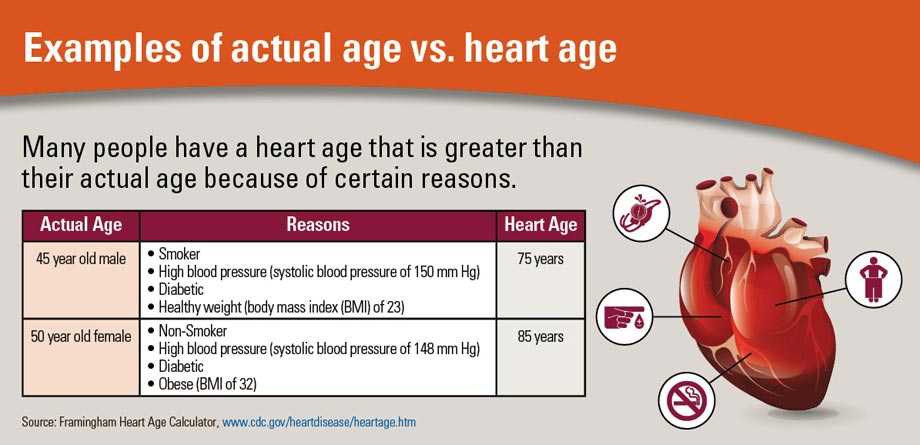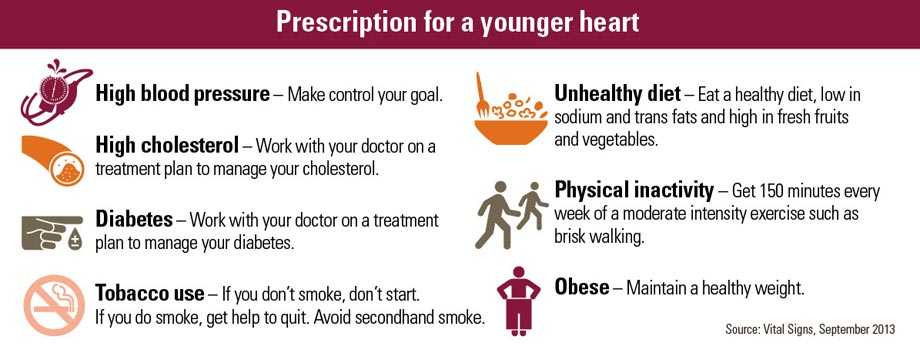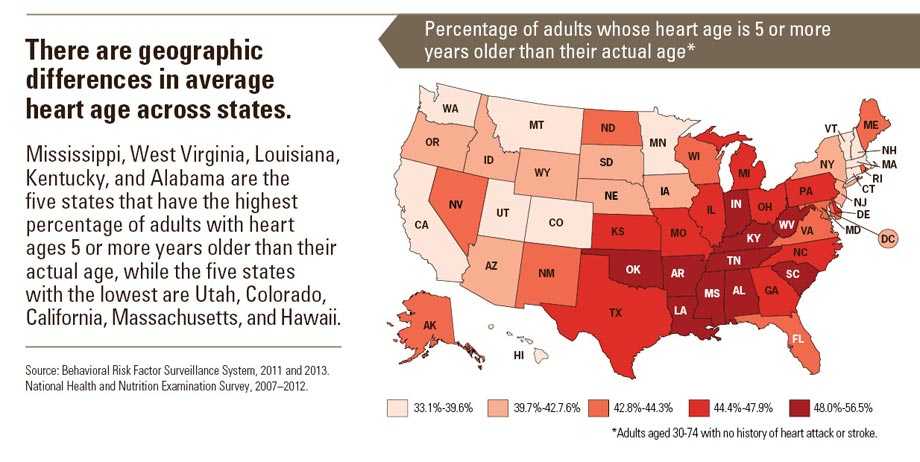Heart Age
Is Your Heart Older Than You?
Overview
Her age is 53. But her heart is 75 years old because she smokes and has uncontrolled high blood pressure. She’s not alone because most American adults have a heart that is older than their actual age. One way to understand your risk for a heart attack or stroke is to learn your “heart age.” Heart age is the age of your heart and blood vessels as a result of your risk factors for heart attack and stroke. There are some things that put you at risk for a heart attack or stroke that you cannot change such as getting older or your family history; yet there are many others that you can change. If you smoke or have high blood pressure, your heart age will be much higher than your actual age. The most common reasons for a higher heart age that can be changed or managed are: high blood pressure, high cholesterol, smoking, obesity, unhealthy diet, physical inactivity, and diabetes. At any age, you can make your heart younger by making changes that reduce your risk. Even if you haven’t had a heart attack or stroke, most US adults have a heart age older than their actual age placing them at greater risk of having one.
What you can do:
- Learn your heart age and how to improve it.
- Start by choosing a risk factor or two that you’re ready to change, like smoking or high blood pressure, and focus on improving them first.
- Work with your doctor to make heart healthy choices for a lower heart age.
- Take action at any age to lower your heart age and keep it low over time.
On This Page

Problem
US adults have hearts 7 years older than they should be.
Though there are other ways of looking at your risk for having a heart attack or stroke, heart age is an easy way for us to talk about it. You want a heart age that is the same or younger than your actual age. Using information from the Framingham Heart Study and data collected from every US state, CDC projections show that around 69 million US adults that haven’t had a heart attack or stroke, have a heart age that is 5 or more years older than their actual age. That’s about the number of people living in the 130 largest US cities combined. One in 2 men and 2 in 5 women have heart ages 5 or more years older than their actual age, with the average being 7 years older.
Having an ideal blood pressure (less than 120/80) lowers your heart age.
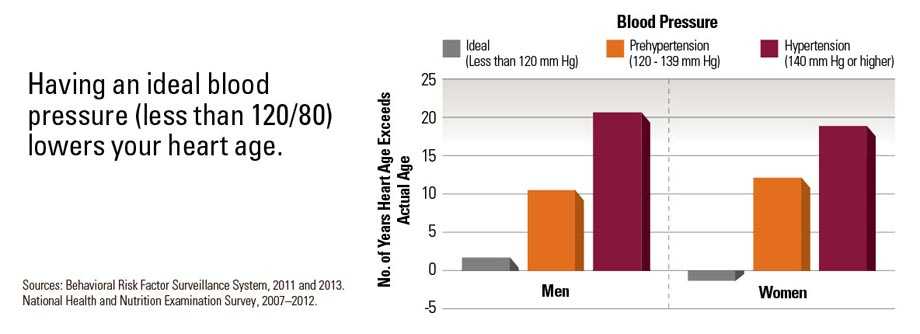
View large image and text description
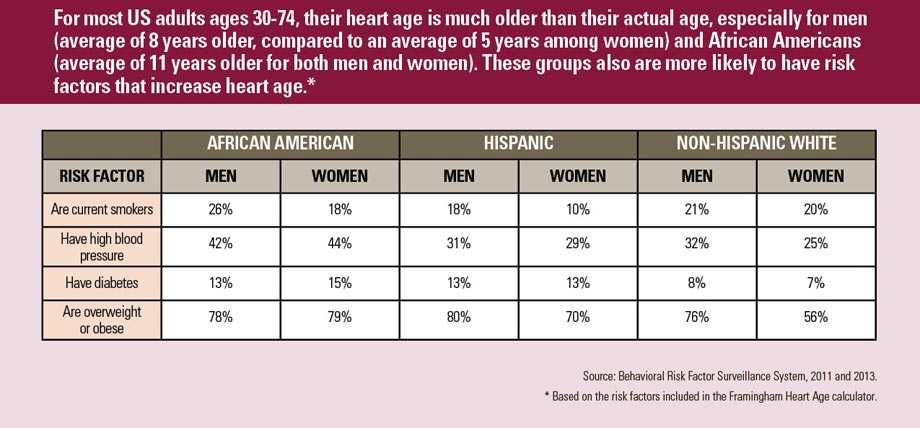
What Can Be Done
The Federal government is:
- Requiring most health plans to cover recommended preventive services at no out-of-pocket cost (such as co-pays or deductibles) through the Affordable Care Act, for example, blood pressure screening and tobacco cessation interventions and counseling to prevent heart disease and stroke.
- Leading the national Million Hearts® initiative to prevent 1 million heart attacks and strokes by 2017.
- Providing resources to all 50 states to address chronic disease prevention, including heart disease and stroke, including through the Prevention and Public Health Fund.
- Leading national campaigns that address causes of heart disease and stroke, such as Let’s Move!, and Tips from Former Smokers.
States can:
- Promote safe walking areas and access to healthy food in communities.
- Address tobacco use comprehensively by promoting smoking quitlines and tobacco-free areas, increasing the price of tobacco products, and running hard-hitting anti-tobacco ads.
- Partner with hospitals to identify and address the health care issues in their community.
- Prevent heart disease and stroke by using easily understood communication materials to promote how to lower heart age and reduce the risk of heart attack and stroke.
Doctors, nurses, and other healthcare providers can:
- Calculate heart age among your patients aged 30–74 and talk with them about the effect of risk factors on their heart health.
- Help patients choose a risk factor or two to focus on improving first, such as quitting smoking, getting regular exercise, making healthy eating a part of their lives, and helping them take their medications as prescribed.
- Refer patients to community resources such as smoking quitlines and diabetes prevention programs that will support them as they make and keep these lifestyle changes.
- Continue to use other calculators recommended by national guidelines that assess cardiovascular risk and help inform treatment decisions.
Everyone can:
- Learn your heart age and how to improve it.
- Start by choosing a risk factor or two that you’re ready to change, like smoking or high blood pressure, and focus on improving them first.
- Work with your doctor to make heart healthy choices for a lower heart age.
- Take action at any age to lower your heart age and keep it low over time.
Issue Details
Related Pages
- Heart Age Calculator
- Vital Signs Issue details: Predicted Heart Age and Racial Disparities in Heart Age Among U.S. Adults at the State Level, Morbidity and Mortality Weekly Report (MMWR)
- Vital Signs – Heart Age [PODCAST – 1:15 minutes]
- Vital Signs – Heart Age [PSA – 0:60 seconds]
- How Old Is Your Heart? Learn Your Heart Age! [VIDEO – 1:109 minutes]
- CDC Digital Press Kit
- Heart Disease
- Stroke
- Tips From Former Smokers
- Page last reviewed: September 1, 2015
- Page last updated: September 1, 2015
- Content source:
- National Center for Chronic Disease Prevention and Health Promotion
- Page maintained by: Office of the Associate Director for Communications (OADC)


 ShareCompartir
ShareCompartir
